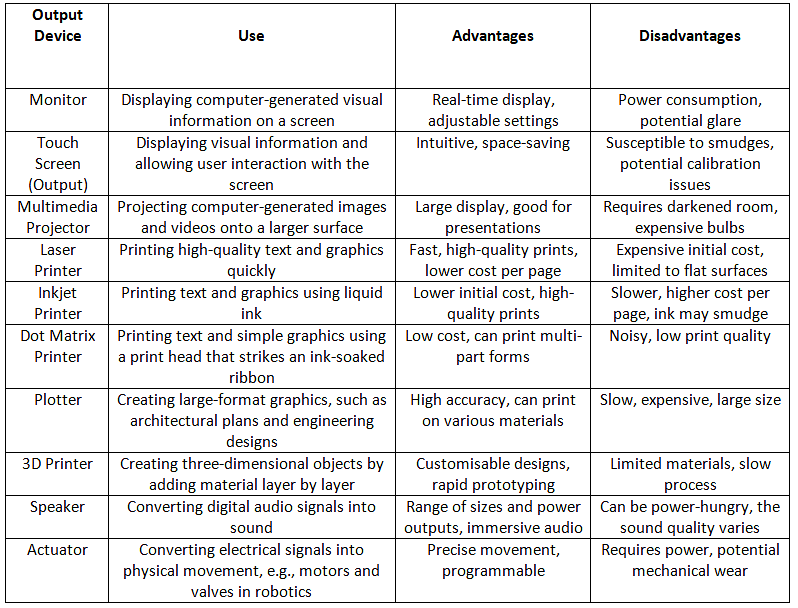Year 11 Exam > Year 11 Notes > IGCSE Information and Communication Technology Preparation > Output Devices
Output Devices | IGCSE Information and Communication Technology Preparation - Year 11 PDF Download
Characteristics of Output Devices
- Output devices: these devices display or produce the results of data processing from a computer system.
- Examples include:
- Monitor
- Printer
- Speakers
- Projector
Differences between Input & Output Devices
- Input devices transmit data or instructions to the computer, while output devices receive data from the computer.
- Input devices are utilized for user interaction and data entry, whereas output devices showcase or generate the results of data processing.

Holographic imaging
- Holographic imaging is a method for generating three-dimensional images by recording and reconstructing light waves.
- These images offer a realistic and immersive visual experience.
- In the medical field, holographic imaging could be applied to produce:
- MRI scan images,
- Ultrasound images, and
- Three-dimensional views of internal organs.
- By employing holographic imaging techniques, medical professionals could potentially enhance their ability to visualize and understand complex anatomical structures, leading to improved diagnostics and treatments.
Question for Output DevicesTry yourself: Which of the following devices is an output device?View Solution
The document Output Devices | IGCSE Information and Communication Technology Preparation - Year 11 is a part of the Year 11 Course IGCSE Information and Communication Technology Preparation.
All you need of Year 11 at this link: Year 11
FAQs on Output Devices - IGCSE Information and Communication Technology Preparation - Year 11
| 1. What are some examples of output devices used for holographic imaging? |  |
Ans. Some examples of output devices used for holographic imaging include holographic projectors, holographic displays, and holographic screens.
| 2. How do output devices contribute to the creation of holographic images? |  |
Ans. Output devices play a crucial role in the creation of holographic images by projecting or displaying the holographic content in a way that allows the viewer to see a three-dimensional image.
| 3. Can output devices be used for purposes other than holographic imaging? |  |
Ans. Yes, output devices can be used for a variety of purposes beyond holographic imaging, such as displaying images on computer monitors, printing documents, and projecting videos on screens.
| 4. What technology is commonly used in output devices for holographic imaging? |  |
Ans. Output devices for holographic imaging often utilize advanced technologies such as laser beams, diffraction gratings, and spatial light modulators to create realistic three-dimensional images.
| 5. How does the quality of output devices impact the viewing experience of holographic images? |  |
Ans. The quality of output devices significantly affects the viewing experience of holographic images, with higher-quality devices producing sharper, more vivid, and more immersive holographic visuals for the viewer.
Related Searches




















